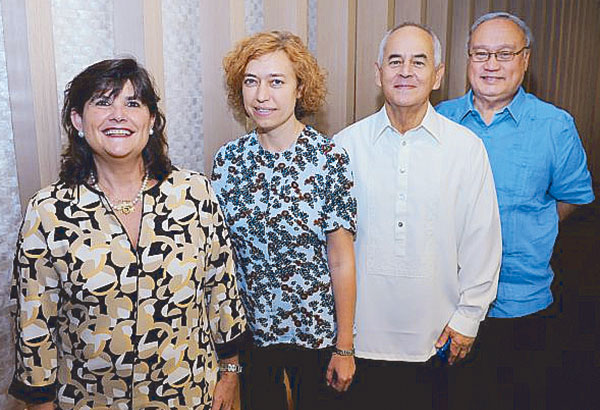
Dr. Ana Martinez PhD, chief scientist and research professor of CSIC (Centro de Investigationes Biologicas), Dr. Carmen Gil, Ankar Pharma founder Jose Mari Olbes, and Philippine Spanish Business Council chairman Jose Leviste
October 2014
MANILA, Philippines – It can start with fatigue, forgetfulness or sudden shooting pain. It can also begin with vision problems, numbness, a tingling sensation, dizziness or problems with coordination. Precisely because the early signs of multiple sclerosis are similar to that of other pathologies, it is a disease that is more often diagnosed in its later stages.
“Multiple sclerosis (MS) is a neurodegenerative disease that occurs when neurons or cells in the nervous system, brain, and spinal cord begin to deteriorate,” says Dr. Ana Martinez, research professor at the Biological Research Center (CIB) of the Spanish National Council for Research (CSIC). “As one of the world’s most common neurological disorders, MS is the leading cause of non-traumatic disability in young adults. MS is frequently diagnosed between ages 20 and 40 years old and is more frequent in women than in men, with a 3:1 ratio in the most recent studies.”
Dr. Martinez explains that MS is a demyelinating condition wherein the myelin, the fatty material that covers or insulates nerves is damaged so that the ability for nerves to transmit impulses rapidly is impaired. “MS is a progressive autoimmune disorder where the immune system mistakenly attacks and destroys healthy body tissue. But why this happens isn’t known.
“What we know is that the damage is caused by inflammation.” While family history and aging are major risk factors for MS, Dr. Martinez tells us that lifestyle choices (stress reduction, moderate exercise, antioxidant intake, and cessation of smoking) can slow down the progress of the disease.
The most common type of MS that affects about 85 percent of those diagnosed is Relapsing Remitting MS (RRMS) where attacks are followed by recovery and a remission of symptoms so that the patient feels normal until the next episode of an attack. While the disease is considered “stable” at this time, it can happen that a patient will not return to his previous condition level after an attack. What this means is that damage to the nerves has occurred and scar tissue forms where damage is incurred in the nerve sheath. Disease-modifying drugs are the current treatment for active RRMS. These suppress the immune system so that it doesn’t attack the protective myelin surrounding the nerves, thereby slowing down the progression of MS and preventing relapses.
It is unfortunate that RRMS tends to shift to a more progressive type with aging and the symptoms are expectedly more severe as the disease worsens. Apart from muscle weakness, difficulty of coordination and balance, paresthesia (or a sensation of tingling, tickling, prickling, or burning of a person’s skin), there can be loss of sensation, spasticity, and fatigue. More disturbing is that many MS patients “suffer some degree of cognitive impairment especially affecting the working memory, long-term memory, and executive function. There can be speech impediments, tremors, and hearing loss.”
Click here to continue reading
~~~~~~~~~~~~~~~~~~~~
.
WATCH OUR Multiple Sclerosis recorded
EDUCATIONAL VIDEOS by Topic:
EDUCATIONAL VIDEOS by Topic:
click:: www.youtube.com/msviewsandnews
.
Visit our MS Learning Channel on YouTube: http://www.youtube.com/msviewsandnews


